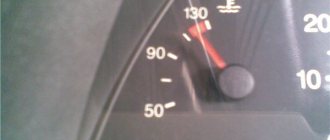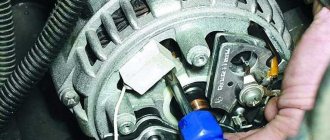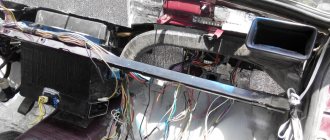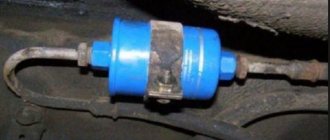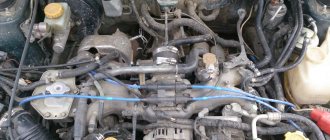CAUSES OF ENGINE OVERHEATING
Overheating can be caused by many reasons, all of them are related to a malfunction of the cooling system, or the quality of the coolant, as well as contamination of the cooling system jacket, which impairs the fluid throughput. It is important to use high-quality spare parts, otherwise the reasons below will happen suddenly. Let's look at each of the reasons.
LOW COOLANT LEVEL
The most common problem is a lack of coolant in the system. Coolant, in the form of antifreeze or antifreeze, constantly circulates through the system, removing heat from heated engine parts. If the coolant level is insufficient, the heat will not be removed sufficiently, which means an increase in temperature will be inevitable.
If it is not possible to add coolant, then turn on the heater to reduce the likelihood of overheating. As a last resort, add regular or distilled water, after which the cooling system must be flushed and then filled with fresh antifreeze. At temperatures above 90 degrees, you should immediately stop the car, turn off the ignition, and allow the engine to cool.
ELECTRIC COOLING FAN FAILED
The electric fan forces cool air onto the radiator, which is especially necessary when driving at low speeds when there is insufficient air flow. The fan can be installed either in front or behind the radiator. If the temperature arrow starts to rise, stop the car and check the fan for serviceability. Reasons for fan failure:
To check the fan, remove the connectors from it and connect the wires directly to the battery, which will allow you to determine the cause of the failure.
THERMOSTAT FAULT
The thermostat is one of the main elements of the cooling system. The cooling system has two circuits: small and large. A small circuit means that fluid circulates only through the engine. In a large circuit, fluid circulates throughout the system. The thermostat helps you quickly reach and maintain operating temperature. Thanks to the sensitive element, which opens the valve at 90 degrees, the liquid enters a large circle, and vice versa. The thermostat is considered faulty in two cases:
The thermostat can be located directly in the cylinder block, in a separate housing, or as one unit with a temperature sensor and pump.
BROKEN COOLING FAN BELT
On vehicles with a longitudinally mounted engine, the fan can be driven by a drive belt from the crankshaft pulley. In this case, the fan works forcibly. The service life of the drive belt is from 30 to 120 thousand km. Typically, several units are driven by one belt. When a belt breaks, the internal combustion engine immediately tends to overheat, especially when the speed decreases. If you have a domestic car with a belt-driven fan, it is recommended to install an additional electric fan to avoid unpleasant incidents.
DIRTY RADIATOR
Once every 80-100 thousand kilometers it is necessary to flush the radiator along with the entire cooling system. The radiator becomes clogged for the following reasons:
To wash the radiator, you should use special compounds that are added to old antifreeze; the engine runs on this “mixture” for 10-15 minutes, after which you need to remove water from the system. It is advisable to remove the radiator and wash it with water under pressure, inside and out.
Consequences of mild, moderate and severe overheating
The consequences and cost of repairs depend on the degree of overheating of the internal combustion engine. Timely maintenance of the car, monitoring the coolant level and temperature conditions when driving reduces the occurrence of overheating significantly.
Slight overheating of the internal combustion engine occurs when the engine operates at a temperature exceeding the temperature for 4-12 minutes. This mainly occurs when the thermostat or fan malfunctions, and the driver detects this in a timely manner and takes action.
In many cases, such a situation, if it occurs once, does not affect the condition of the engine, especially if it has a short mileage. The pistons often melt slightly; when the temperature rises significantly, even for a short time, dark-colored smoke appears from the muffler, and there is a feeling that the engine is constantly running under load.
Even after a single short-term overheating of the engine, it will subsequently begin to heat up more often due to changes in the pistons and the remaining melted metal in the cylinders.
The average degree of overheating of the internal combustion engine appears when the engine is running at extreme temperatures for at least 20 minutes. There are many reasons for this situation and they have all been described earlier.
The consequences of such overheating are already more tragic. In addition to the consequences characteristic of mild overheating, which manifest themselves to a greater extent, there are added skew of the cylinder head or the appearance of cracks in it, burnout of cylinder head gaskets, ejection of the valve seat, severe deformation of the pistons, destruction of the inter-ring partitions of the pistons, oil leakage from under all kinds of gaskets and seals .
Severe overheating of the internal combustion engine causes all sorts of very serious consequences. In this case, individual working units may survive or the engine can be thrown out.
What should be the operating temperature of the VAZ 2107 engine?
Comments 14
Participate in the discussion can only registered users.
Same question: My radiator is boiling at a level between the white and green zones. The two wires going to the temperature sensor installed on the radiator do not connect to each other when you connect them to each other... I don’t know what to do, what to do, who can tell me? I also wanted to know what zone is normal? Car VAZ 21074 (2004 Carburetor)
My fan turns on between the white and green scales. When the arrow is in the middle the entire scale is complete. Well, or it looks the other way - the car is boiling
The same problem! Tell me within what limits the arrow should be?! I’m in the white zone, almost to the green and it’s not going any further! Shouldn’t it be on the green in the middle or a little further?! After all, it’s not normal to drive when the engine is not at operating temperature?! The stove seems to be working fine! This means the temperature is normal, maybe the sensor itself is faulty?!
I have a temperature sensor for the fan at 78-80 and the temperature doesn’t rise too high either, I dropped one wire from the sensor and threw it on the button in the interior from the fan. On the street it was minus 30 - 40 and I went crazy in the cabin. and the idea is to have 2 Niva fans and 2 temperature sensors)
During normal driving in winter and summer, the temperature is almost in the middle a couple of mm after white, but on the highway after 160 the temperature rises (you have to turn the heater on to maximum, how can you prevent the temperature from rising?
judging by the photos this is normal (if the fan should work from the red zone to the white zone) if from white to red to the right this is bad somewhere the fan sensor or thermostat is covered or there is little antifreeze in the system or there is air in the system
I bought a car with almost the same scales as yours, and I’m also struggling with the notations... I’m also interested in the question of how the needle should behave and when the valve should turn on. And when the ignition is turned off, does the arrow go down a lot?
Tomorrow I'll take a photo of how it looks when it's turned off
I have an on-board computer, the factory setting for turning on the fan was 98 degrees, set it to 97 degrees
if the radiator is hot, then everything is fine, I always have between white and green the radiator is hot at this time
For me in the summer it turns on from the red zone mm 5 it comes out there depending on the temperature on the sensor! and now it generally turns on when it wants, apparently to the Khan sensor! I think when it comes out of red, the thermostat should work, well, again, it’s different for everyone)))
in fact, it should be approximately exactly 90 degrees, maybe just short of the central position, when did you change the scales and take off the arrow? Maybe I didn't install it correctly?
it was the same with the factory dials, it came out of red and the fan turned on
on the factory red scale this is already overheating, first white goes then green, look, maybe the fan switch sensor needs to be changed
Comments 74
Participate in the discussion can only registered users.
It's about nothing. In order for the temperature indicator to show not the weather on Mars, but the engine temperature, it needs to be calibrated for a specific TM-106. I showed it myself until it began to gurgle in the expansion tank...
And I drive like this and everything’s fine
Well, I’m not boiling either. I actually thought it wasn't heating up.



